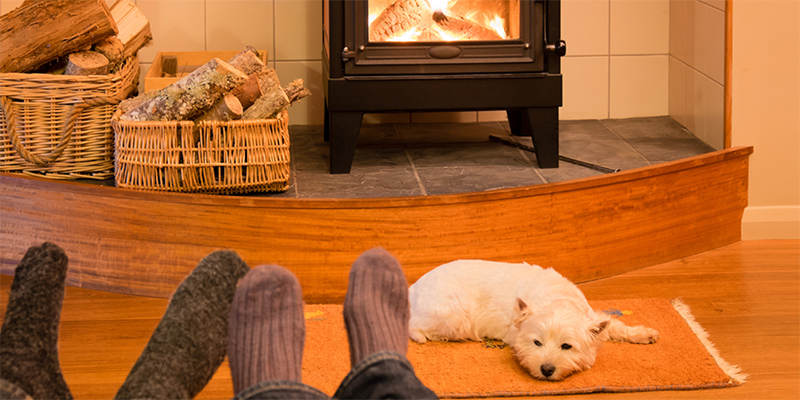Winter at home is much more enjoyable in a warm house
By Dan Lander
 TECHNOLOGY AND ENGINEERING
TECHNOLOGY AND ENGINEERINGWinter is here and, even with COVID-19 lockdowns easing, the large number of Australians still working from home will not only be feeling the chill, but also the financial strain that comes with warming up.
The social impacts of the coronavirus pandemic have changed many aspects of modern life, and researchers at UniSA’s Research Node for Low Carbon Living suggest the thermal efficiency of the houses we live in deserves some serious scrutiny.
Dr David Whaley and Dr Stephen Berry are two of Australia’s leading experts on low-energy housing, and their research shows the standards set for Australia’s residential buildings are simply not sufficient for the climate we build them in – whatever the season.
“With so many people spending such large amounts of time in their homes right now, I think many of them are realising the high cost and low comfort of inefficient housing,” Dr Berry says.
“If your home hasn’t been built to sufficiently keep out the cold, this winter, perhaps more than any other in most people’s lives, you’re going to feel it, either in your hip pocket or in your bones.”
Over the past few years, the Research Node for Low Carbon Living has amassed a wealth of data demonstrating how simple construction principles or basic retrofitting can dramatically improve the comfort of a house while simultaneously reducing energy bills and lowering carbon emissions.
“The key ideas are really very simple,” Dr Whaley says. “First and foremost, you need to ensure your house is airtight, without gaps around doors and windows and joints in the building; secondly, you need to insulate, everywhere, including double or even triple glazed windows.”
Dr Berry says that “just when you think you’ve insulated enough, insulate a little more”.
In addition, the pair recommend installing rooftop solar and positioning windows to allow the sun to warm a house in winter while blocking it out in the summertime, as well as allowing adequate cross ventilation for passive cooling.
And if that all seems rather simple, the problem is that Australia’s currently lax building regulations mean most new dwellings don’t go far enough in following those basic guidelines, while many older dwellings are even worse.
“The current minimum of six-star energy rating for new homes is well below most other developed nations, and does nothing to encourage owners, builders and developers to embrace really efficient housing design,” Dr Berry says.
“Until that standard is raised, there won’t be any real awareness of the issue, or change in building practice, and people will continue to rely on high energy consumption to heat and cool their homes.”
Dr Whaley recently built a new home in Adelaide to the highest possible energy standards possible given his budget, and he says the air tightness and comfortable living conditions more than justify the relatively minor upfront expense the process entailed.
“I had to work quite closely with the builders to ensure we reached the standard I was after, and a lot of it wasn’t things they were used to doing or aware of, but once it was introduced to them, they were all very keen to learn more, which is pretty encouraging,” he says.
“Now, even on a 40-plus day in summer, I don’t need to turn the air conditioning on, and so far this year, the heater hasn’t had to come on either.”
Perhaps most telling is research undertaken by the Node for Low Carbon Living, based on real world dwellings including those at Adelaide’s Lochiel Park ‘Green Village’, which suggests houses built to similar standards as Dr Whaley’s not only offer financial and environmental benefits, they actually make for happier people.
Dr Berry say they have the research and data "to show that people moving into energy efficient housing consistently notice an improvement in their quality of life".
“They are more comfortable in their daily activities, they sleep better, they have less anxiety about their carbon footprint and their energy bills, and the savings they make can be spent on the things they enjoy,” he says.
The Research Node for Low Carbon Living provides a range of resources for homeowners and builders interested in retrofitting their existing home to improve energy efficiency or in building a new home to the highest possible energy standards.
Other Stories
- World-first contraceptive gel developed by UniSA researcher to hit the US market
- UniSA wins $7.8m for research to prevent infections, diagnose medical conditions and improve aged care
- SA scientists find breast cancer link in world breakthrough
- Alien frog invasion wreaks havoc on natural habitat
- From the Vice Chancellor
- Achievements and Announcements
- Video: Parenting in a pandemic – how children’s lives will change after COVID-19
- The death of open plan offices? Not quite, but trust and autonomy the new norm in workplaces
- Winter at home is much more enjoyable in a warm house
- UniSA Online offers new 100 per cent online accredited psychology degree
- Workplace flexibility: will it disappear with social distancing?
- Hidden mental health issues among refugees
- Veteran and first responder wellbeing program to expand by offering occupational therapy
- The latest books from UniSA researchers
- In Pictures: UniSA students head back to school




